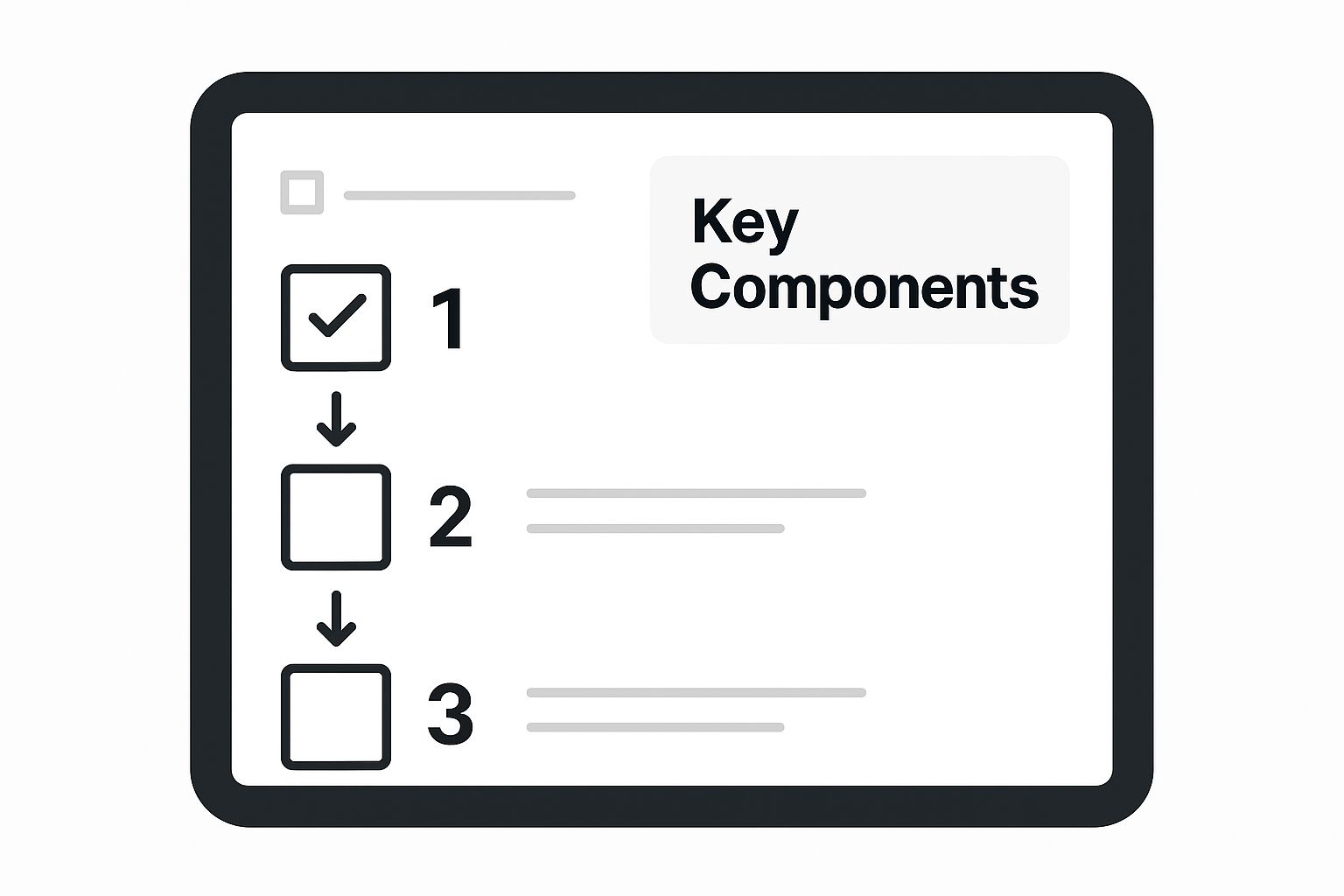A solid sample email consent form is way more than just a legal box to tick. Think of it as your first handshake with a potential customer. It’s your chance to signal right from the start that you're transparent and you respect their inbox.
Why Your Email Consent Form Matters More Than Ever

In an age of endless data breaches and people being more protective of their privacy than ever, how you ask for an email address says a lot about your brand. A clear, honest consent process isn't just about dodging massive GDPR fines anymore. It's now a core part of building an email list full of people who actually want to hear from you.
Let's be real: subscribers who knowingly and willingly opt-in are the ones who will open your emails, click your links, and eventually become customers. On the flip side, murky or tricky forms are a fast track to high unsubscribe rates, spam complaints, and a trashed sender reputation. ISPs notice that negative feedback, and it can absolutely destroy your email deliverability over time.
From Legal Hurdle to Strategic Asset
When you start seeing your email consent form as a strategic tool, you flip the script. It stops being a compliance headache and becomes a genuine growth opportunity. This is your moment to filter out the tire-kickers and start building relationships with people who are genuinely interested.
That trust is everything, especially since today's consumers are getting smarter and more guarded with their personal info.
A well-designed consent form is your best quality filter. It makes sure you're talking to people who want to be in the conversation, which is the whole foundation of a successful email marketing strategy.
The demand for this kind of transparency is only growing. By 2025, 39% of consumers say that getting clear information on how their data is used makes them trust a company more. But there's a huge disconnect; only a tiny 3% of Americans feel they fully understand current online privacy laws, even though 92% are worried about their digital privacy.
This is where you can win. By making your consent process dead simple and honest, you build immediate trust. If you're curious, you can dig into more data privacy statistics to see just how much consumers care about this.
Ultimately, a strong consent form helps you build an audience that isn't just big, but loyal and engaged—and that's a far more valuable asset for any business that wants to stick around.
Anatomy Of A High-Converting Consent Form
Let's be honest, a consent form isn't just about ticking a legal box. It's the first real handshake you have with a potential subscriber. A truly effective form balances strict compliance with a user experience that doesn't feel like you're signing a mortgage. It's not just about what you ask, but how you ask.
The single most important part is an explicit call to action. This means your subscriber has to take a clear, deliberate step to opt-in. Think manually ticking a checkbox. Pre-checked boxes? They're not just a GDPR violation waiting to happen; they're a fast track to building a list full of people who don't actually care about your emails.
Clarity Is Your Best Friend
Next up, use plain English. Ditch the vague promises and tell people exactly what they're signing up for.
- Bad Example: "Sign up for our newsletter." (What newsletter? When? Why?)
- Good Example: "Get our weekly B2B growth tips and exclusive access to new lead vaults delivered every Tuesday."
This level of clarity sets expectations right from the get-go, which dramatically slashes your unsubscribe rates later on. You're telling the user what's in it for them, making their "yes" an informed decision, not a blind guess.
A great consent form doesn't just collect an email; it kicks off a relationship built on trust and a clear value exchange. Make the benefit obvious and the action simple.
This infographic breaks down the core components that elevate a basic form into a powerhouse for list-building.

As you can see, the magic happens when you combine that explicit action with a clear value proposition and dead-simple access to things like your privacy policy.
So what's absolutely required versus just a good idea? This table breaks it down.
Essential vs. Recommended Consent Form Elements
| Element | Status | Purpose & Example |
|---|---|---|
| Active Opt-in Mechanism | Essential | Purpose: Ensures explicit consent. Example: An unticked checkbox that the user must manually click. |
| Clear Purpose Statement | Essential | Purpose: Tells users what they will receive. Example: "Sign up for our weekly B2B marketing teardowns." |
| Link to Privacy Policy | Essential | Purpose: Provides transparency on data handling. Example: "Read our Privacy Policy to learn more." |
| Granular Consent Options | Recommended | Purpose: Gives users control and improves engagement. Example: Let users choose between "Weekly Deals" or "New Product Alerts." |
| Unsubscribe Information | Essential | Purpose: Informs users of their right to withdraw consent. Example: "You can unsubscribe at any time." |
| Brand Identity | Recommended | Purpose: Builds trust and brand recognition. Example: Including your company logo and brand colors on the form. |
Making these elements work together is what separates a form that gets ignored from one that builds a high-quality, engaged email list.
Give Users Control With Granular Options
Here’s a pro-level strategy: offer granular consent. Instead of one single "subscribe" button, let people pick their poison. For an e-commerce brand, this might look like:
- Weekly Deals: For the bargain hunters.
- New Product Alerts: For your die-hard brand fans.
- Style Guides & Tips: For those looking for inspiration.
This simple tactic empowers your subscribers. They feel in control, and you get to send them content they've explicitly said they want. The result is sky-high engagement and a much healthier, more responsive email list.
To make sure your current setup is solid, it's worth running a quick check with an email marketing audit checklist. It can help you find any weak spots in your consent process before they turn into major headaches. And always, always include a very visible link to your privacy policy. This isn't just a legal requirement; it's a non-negotiable part of building trust.
Navigating Global Email Privacy Laws

When your business lives online, your audience is everywhere. That means your consent process needs to be global, too. Getting a handle on the big three—Europe's GDPR, the US's CAN-SPAM Act, and Canada's CASL—is non-negotiable if you want to dodge hefty fines and build trust with an international audience.
The real crux of it boils down to one simple concept: "opt-in" vs. "opt-out."
GDPR is the strictest of the bunch, demanding explicit opt-in. This isn't a suggestion; it's a rule. A user has to take a clear, undeniable action—like ticking a box that was not pre-ticked for them—to subscribe. You simply cannot assume you have their permission.
On the flip side, the US CAN-SPAM Act runs on an opt-out model. You can technically send that first email without prior consent, but you are legally required to provide a dead-simple way for them to unsubscribe. Canada's CASL is a bit of a hybrid, requiring either implied or express consent.
Adopting the Highest Standard
So, which playbook do you follow when the rules seem to contradict each other?
My advice is always the same: build your entire consent process around GDPR's strict opt-in model. I call this the "highest standard" approach. It's the safest, most future-proof strategy you can adopt. Why? Because it makes you compliant almost everywhere by default.
Designing your sample email consent form this way from day one saves you from monumental headaches down the road. It simplifies your operations and protects your brand's reputation, no matter where your subscribers are.
The smartest move for any global business is to design for the strictest law. Adhering to GDPR's explicit opt-in model makes your consent process universally compliant and builds deeper user trust.
This isn't just a best practice; it's becoming the global norm. As of 2025, international email regulations have continued to tighten, with a much stronger focus on explicit consent, especially as AI-driven personalization becomes more common. We're seeing a trend where laws like CAN-SPAM and CASL are gradually aligning with the core principles of GDPR.
Just remember, your consent form doesn't exist in a vacuum. It's a critical piece of your compliance puzzle and must line up perfectly with what you promise in your privacy policy.
Alright, let's break down how to actually write an email consent form that people will sign up for and that keeps you on the right side of GDPR. This isn't just about slapping some legal text on a page; it's a careful blend of persuasive copy and crystal-clear compliance.
Think of this tiny bit of real estate on your site as your first handshake. It needs to feel confident, clear, and smart. Let’s get into the nitty-gritty of crafting copy that works, whether you're a buttoned-up B2B service or a laid-back e-commerce brand.
Headline and Value Proposition
Your headline is your first—and often, your only—shot to grab someone's attention. Don't blow it. It needs to be driven by the benefit to the user, instantly answering their silent question: "What’s in it for me?"
Right after that hook, drop a short sentence or two that backs it up with specifics. Be direct.
Headline Example (B2B): Get Actionable Sales Intel for the Irish Market
Value Prop Example (B2B): Join our list for free lead vault drops, proven cold email sequences, and expert B2B growth tactics delivered every Tuesday.
See how that works? It nails the benefit (sales intel), gets specific about the goods (lead vaults, email sequences), and even sets an expectation for how often they'll hear from you (every Tuesday). No ambiguity.
The Consent Statement and Checkbox
This is where the legal rubber meets the road. Your consent language has to be completely unambiguous. The user needs to make an active, informed choice. That means never, ever use pre-checked boxes. It's a one-way ticket to compliance trouble.
The text right next to your checkbox should state plainly what they're agreeing to.
- Casual E-commerce Style:
[ ]Yes, I'd love to get weekly style tips and be the first to know about new arrivals! - Formal Service Provider Style:
[ ]I agree to receive marketing communications and understand I can unsubscribe at any time.
Both of these examples are direct and they don't try to bundle consent with other stuff, like agreeing to your terms of service. That’s a huge GDPR no-no. For a much deeper look at getting your whole process in line, our GDPR compliance checklist breaks down every single requirement.
Button and Unsubscribe Text
Finally, you need a call-to-action (CTA) button that seals the deal. Ditch the generic "Submit" and use active language that reminds them of the value they're about to get.
- "Get My Free Tips"
- "Unlock Access"
- "Send Me the Deals"
Just underneath the button, it’s a smart move (and a legal best practice) to add a simple reminder that they can leave whenever they want. This builds a surprising amount of trust. A simple, "You can unsubscribe at any time" is all you need.
To make this even easier, you can grab our customizable sample email consent form to get started. It pulls all these pieces together into a template you can tweak to fit your brand's voice and offers, setting you up to build a list that’s both engaged and compliant from day one.
Of course, here is the rewritten section, crafted to sound completely human-written and natural, following the provided style guide and examples.
Common Consent Form Mistakes to Avoid
Even the sharpest, most well-meaning businesses can stumble when putting together an email consent form. Trust me, learning from these common face-plants is the fastest way to build a process that’s both compliant and actually works—protecting your sender reputation and building real subscriber trust.
One of the most frequent—and damaging—mistakes I see is using pre-checked boxes. Under GDPR, consent has to be an active, affirmative choice. Assuming a user wants your emails by pre-ticking a box for them is a direct violation. It's also a surefire way to fill your list with ghosts who will quickly mark you as spam.
Another critical error is bundling consent. You can't just lump permission for marketing emails in with your Terms of Service agreement under a single checkbox. Each type of consent needs to be separate and distinct. This gives the user granular control over exactly what they’re agreeing to, which is the whole point.
Vague Language and Hidden Details
Clarity is non-negotiable. So many forms fail right here, burying the consent language in fine print or using vague phrasing that doesn’t specify what the user will actually get. This approach isn't just a terrible user experience; it's legally flimsy.
A consent form isn't a legal trap; it's a transparency tool. If someone feels tricked into subscribing, you haven't gained a lead—you've created a future spam complaint.
Let’s look at a quick ‘before’ and ‘after’ to see what I mean.
Before (Vague & Bundled):
[x] By creating an account, I agree to the Terms of Service and to receive emails from Awesome Inc.
After (Clear & Unbundled):
[ ] I agree to the Terms of Service.
[ ] Yes, send me weekly B2B growth tips and new product updates. I know I can unsubscribe at any time.
The 'after' version is miles better. It separates the legal stuff from marketing consent and clearly states the value proposition. This is fundamental, especially when you consider how GDPR impacts cold outreach in Ireland, a market that demands a seriously high standard of transparency.
Finally, a frustrating unsubscribe process is a massive own goal. If a user can't easily find a way to opt out, they won't hesitate to smash that spam button. That directly torpedoes your sender score and future deliverability. Your 'unsubscribe' link must be obvious, and the process has to be dead simple.
Common Questions About Email Consent (And a Few You Didn’t Think to Ask)
Getting email consent right can feel like walking a tightrope. You know the rules, but applying them to real-world situations is where things get tricky. I've seen countless businesses wrestle with the same questions, so let's clear up some of the most common points of confusion.
Explicit vs. Implicit Consent: What's the Real Difference?
One of the biggest hang-ups I see is the distinction between explicit and implicit consent. It's a critical difference.
Explicit consent is when someone takes a clear, deliberate action to say "yes." Think of them actively ticking an unchecked box on your signup form. It’s an undeniable, recorded permission slip.
Implicit consent is assumed. A classic example is when a customer gives you their email for a receipt, and you quietly add them to your marketing list. Under GDPR, this is a no-go. For marketing emails, explicit consent isn't just the gold standard; it's the only legally sound way forward.
What About My Existing Email List?
This is the question that keeps marketers up at night: "Do I need to get new consent from my existing email list?"
If your old list was built with tactics that don't meet today's explicit consent standards (like using pre-checked boxes or vague language), then the answer is a firm yes. You'll need to run a re-engagement campaign to get fresh, compliant permission from those subscribers. It’s better to have a smaller list of engaged, willing contacts than a massive list of people who never truly opted in.
Bundling Consent: The One-Checkbox Mistake
In the name of efficiency, people often ask if they can use a single checkbox for both their terms of service and newsletter signup. Please don't. This practice, known as "bundling consent," is a major GDPR violation. Every specific reason you have for processing someone's data needs its own separate, unbundled consent.
Remember, the whole point of consent is to give your audience clarity and control. Any shortcut you take that muddies their choice erodes the very trust you're trying to build.
Finally, how often should you review your sample email consent form? I tell my clients to review it at least once a year or anytime there's a significant update to privacy laws. This proactive habit keeps your practices compliant and effective. This is especially crucial when you're trying to generate B2B leads in a competitive landscape where trust is your most valuable asset.
At DublinRush, we provide the data-driven tactics and actionable frameworks to accelerate your sales performance across Ireland. Equip your team with curated lead vaults and proven email sequences to scale your outreach effectively. Learn more at DublinRush.com.
